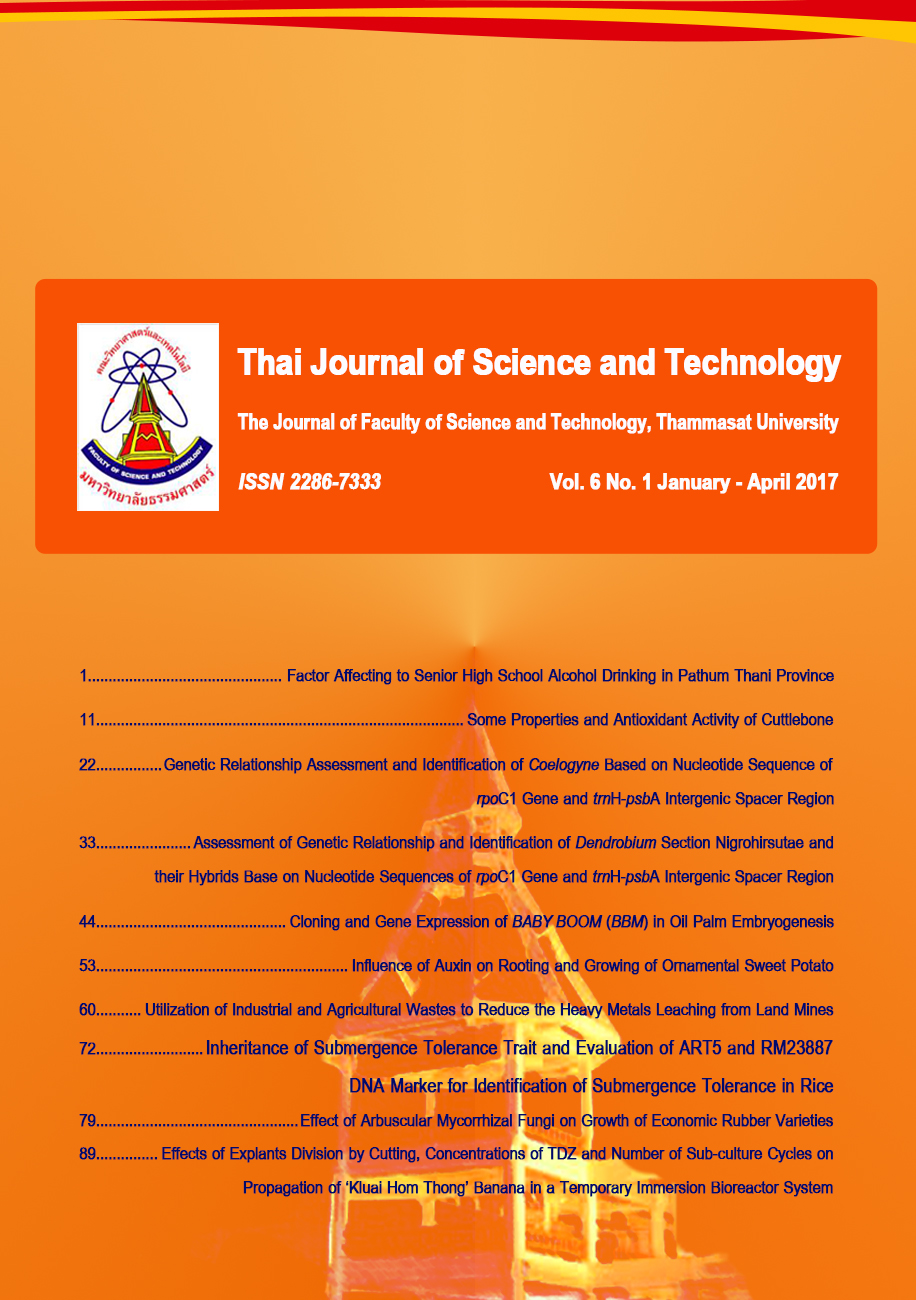การใช้ประโยชน์ของเสียจากอุตสาหกรรมและเกษตรกรรมในการลดการชะละลายโลหะหนักออกจากดินที่ปนเปื้อนจากพื้นที่เหมือง
Main Article Content
Abstract
บทคัดย่อ
งานวิจัยนี้ศึกษาการใช้ประโยชน์วัสดุเหลือทิ้งจากภาคอุตสาหกรรมและเกษตรกรรม เพื่อลดการชะละลายโลหะหนักออกจากดินพื้นที่เหมืองแร่ โดยวิเคราะห์โลหะหนักตามวิธี US. EPA 3051 สำหรับตัวอย่างดินและเถ้าลอยลิกไนต์ และ US. EPA 3015a สำหรับตัวอย่างน้ำ และวิเคราะห์ด้วยเครื่อง AAS ศึกษาการชะละลายด้วยวิธี SPLP และวิธีแบบต่อเนื่อง ผลวิเคราะห์พบว่า Fe, Pb, Ni, Zn, Cr, Cd และ Cu เท่ากับ 1,353.50, 525.00, 223.00, 192.99, 65.00, 14.35 และ 12.25 mg/kg ตามลำดับ เถ้าลอยลิกไนต์ทั้ง 3 ชนิด และเถ้าลอยลิกไนต์ที่ผ่านการล้าง พบว่ามีปริมาณโลหะหนักสูงกว่าวัสดุชนิดอื่นที่ศึกษา ผลการชะละลายด้วยวิธี SPLP ที่ pH 2.0, 4.2 และ 6.0 พบว่า pH 2.0 Cd, Zn, Fe และ Cu ถูกชะละลายปริมาณสูง นอกจากนั้นเปลือกไข่ ถ่านไม้ไผ่ และปูนขาว สามารถลดการชะละลาย Cd, Zn, Fe และ Cu อย่างไรก็ตาม ถ่านไม้ไผ่มีประสิทธิภาพลดการชะลาย Cd ได้สูงสุด (55.96 %) ดังนั้นการทดสอบการชะละลายแบบต่อเนื่องโดยใช้ถ่านไม้ไผ่ และศึกษาการชะละลายด้วยน้ำที่มี pH 6.0 พบว่าน้ำชะผิวดินมี Fe (0.7781 mg/L) Cu (0.0771 mg/L) Cd (0.0354 mg/L) และ Zn (0.0216 mg/L) ไม่เกินค่ามาตรฐานคุณภาพน้ำผิวดิน น้ำซึมผ่านชั้นดิน ความเข้มข้นของ Fe (0.2595 mg/L) Cu (0.1539 mg/L) และ Zn (0.0232 mg/L) ไม่เกินคุณภาพน้ำใต้ดิน ยกเว้น Cd (0.0342 mg/L)
คำสำคัญ : การชะละลาย; โลหะหนัก; ดินปนเปื้อน
Abstract
In this research, study was carried out on the utilization of residues from industry and agriculture for reducing heavy metals leaching from soil in mining. The studies comprised of heavy metals determination by acid digestion of US. EPA method 3051 for soil and lignite fly ash samples and US. EPA method 3015a for water samples and analysis by AAS. The standard leaching test with SPLP and continuous leaching test were investigated.The results revealed that Fe, Pb, Ni, Zn, Cr, Cd and Cu were detected at concentration of 1,353.50, 525.00, 223.00, 192.99, 65.00, 14.35 and 12.25 mg/kg respectively. Three kinds of lignite fly ash and washed fly ash were contained higher amount of heavy metals than the other studied residues. The leaching results from SPLP at pH 2.0, 4.2 and 6.0 were found that at pH 2.0 Cd Zn Fe and Cu were leached at high level. Moreover, egg shell, bamboo chacoal and lime were able to reduce the leaching of Cd Zn Fe and Cu. However bamboo chacoal gave a highest reducing efficiency of Cd leaching (55.96 % leaching). Therefore, the continuous leaching test by using bamboo chacoal and leaching by water pH 6.0. It was found that in run-off the concentration of Fe (0.7881 mg/L), Cu (0.0771 mg/L), Cd (0.0354 mg/L) and Zn (0.0216 mg/L) were not more than surface water quality standards. In permeate, the concentration of Fe (0.2595 mg/L), Cu (0.1539 mg/L) and Zn (0.0232 mg/L) were in agreement of the ground-water quality standards except Cd (0.0342 mg/L).
Keywords: leaching; heavy metal; contaminated soil
Article Details
บทความที่ได้รับการตีพิมพ์เป็นลิขสิทธิ์ของคณะวิทยาศาสตร์และเทคโนโลยี มหาวิทยาลัยธรรมศาสตร์ ข้อความที่ปรากฏในแต่ละเรื่องของวารสารเล่มนี้เป็นเพียงความเห็นส่วนตัวของผู้เขียน ไม่มีความเกี่ยวข้องกับคณะวิทยาศาสตร์และเทคโนโลยี หรือคณาจารย์ท่านอื่นในมหาวิทยาลัยธรรมศาสตร์ ผู้เขียนต้องยืนยันว่าความรับผิดชอบต่อทุกข้อความที่นำเสนอไว้ในบทความของตน หากมีข้อผิดพลาดหรือความไม่ถูกต้องใด ๆ


